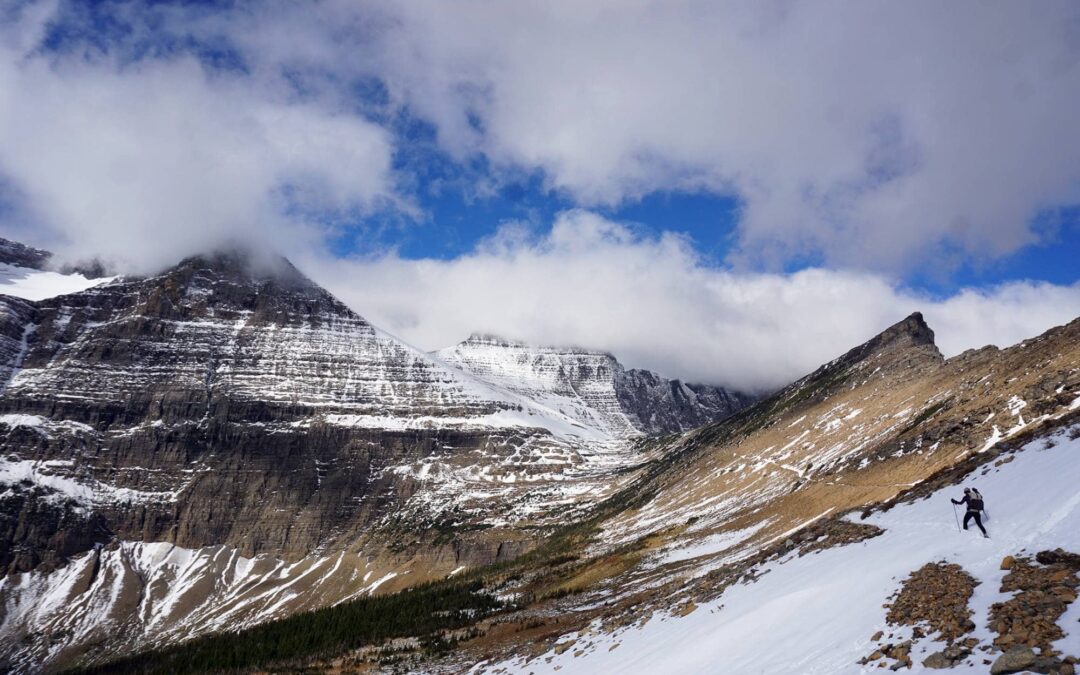by Mike Henrick. Photo by Dan Vardamis.
Thru-hiking the CDT in the spring can often become a mountaineering trip instead of a backpacking trip. In 2019, states along the Continental Divide saw above-average snowfall, with much of Colorado seeing over 150% of the normal snowfall, and the San Juans seeing nearly 225% of their normal snowfall. Hiking in spring conditions – when many alpine areas still have yet to start melting – requires preparation and knowledge of snow safety.
Many thru-hikers will be veterans of other trails like the PCT, which also can feature spring snow travel. However, the Rockies feature a continental snow pack, while the Sierras have a coastal snow pack. Continental snow packs are much weaker due to colder temperatures and an overall thinner snow pack. This means post-holing is much more common on the CDT and so are avalanches which are rare on “Sierra cement” (what skiers commonly call the Sierra snow pack). Far fewer hikers on the CDT compared to the PCT also means no trench in the snow to make travel safer and easier.
That said, travel on the CDT in early spring is certainly not impossible, it just requires special skills and equipment and will be an adventure unlike any other. Going out without those skills or equipment puts you and potential rescuers at risk. In high snow years like 2019, you should avoid traveling north of Chama unless you are able to:
Recognize avalanche terrain and how to avoid it. Colorado has already had half a dozen avalanche deaths this year. New snow will be unstable and prone to wet slides as it heats up for the first few times. Avalanche deaths still happen in May – this is not Sierra snow, but rather a snow pack that is much weaker and more slide-prone. Avalanches are common in spring after snowfall events and when overnight temperatures are too warm to freeze the snow. Wind can drift as little as 6-inches of snow into hard slabs that may not bond well with the ice crust below. Alternatively, when the snow doesn’t freeze you will post hole – even in snowshoes. You should avoid traveling on or under terrain that is over 25 degrees in steepness when you’re sinking past your calves while wearing just boots. See this link to estimate slope angles with your hiking poles. Often to avoid avalanche terrain, the safest place is the crest of ridge lines, but that can force you into rock scrambling that many hikers won’t feel safe doing without a climbing rope, harness and protective gear.
Be able to travel and camp on snow. Assuming a solid freeze overnight you can travel efficiently early in the morning (pre-dawn!) and on shaded slopes, but you will be thigh-deep post holing by the afternoons. Steep icy slopes will be common and mean a fall will result in an uncontrolled slide, so you need to have an ice axe, crampons, and the ability to use them and you must know when to use them. Snow will be continuous above 10 to 11,000 feet depending on aspect and much of the CDT stays above 11,000 feet in the San Juans. You will likely get stuck camping on 4+ feet of snow, so either carry a shovel to dig to the ground or an extra sleeping pad to insulate from the snow. Expect nighttime temps in the teens or lower. You’ll also want to carry snowshoes to extend the time you are able to travel on snow as the day warms. When the snow can no longer support your weight on snowshoes, it’s probably time to call it quits and hope for a solid freeze overnight. Without that freeze, avalanches become more likely and travel almost impossible – best to take a low-elevation alternative. Speaking of which, the sun at 11,000 feet is strong, but the sun at 11,000 feet reflected off the snow is twice as strong. Carry dark sunglasses, cover up, and use sunscreen.
Be willing to bail and have the navigation aids to do so. Spring storms like the one in late April of 2019 that dumped 24+ inches over two days can still happen throughout May. In fact, the biggest snow years gain a lot of their snow in May. Weather prediction in this state is not reliable more than 3 to 4 days out, so you need to be willing to bail to a lower route and have overview maps showing those routes. There are lots of forest service roads below 10,000 feet that will still be scenic and a rewarding hike while avoiding most of the snow.
Tell people where you are going, for how long, and what to do if you don’t show up. When someone goes missing and no one knows until weeks later, the search for them becomes next to impossible, as they could be anywhere over hundreds of trail miles. Piecing together where they likely are becomes much harder. Ideally, carry an emergency beacon and check in at breaks and camp but DO NOT ASSUME THIS MAKES YOU SAFE! Beacons can malfunction or get misplaced and you must be conscious to use them. Even with a beacon, rescue can be delayed for days by bad weather or avalanche conditions. If you are in an emergency situation, you should determine whether you can self rescue or bail – or if the beacon is really necessary. Rural counties have limited resources spread over large service areas, so an unnecessary helicopter flight may prevent someone else from getting aid. If self-rescue is not an option do not worry about the cost of rescue – it’s covered by county sheriffs offices in Colorado. If you want to help ensure no one goes without a rescue because of cash-strapped county sheriffs you can purchase a CORSAR card here.

